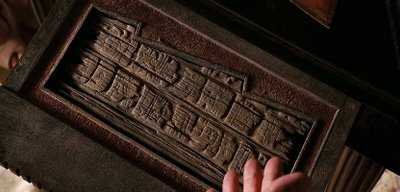Several of these goofs relate to the Olmec culture [spoiler alert]:
Factual errors: Gold was barely known or completely unknown to the ancient Olmec culture. Of course subsequent cultures found it and used it, but that was a couple hundred years later.
Factual errors: When the group sees an altar in the city of gold, and Emily exclaims that that "this will really open up the study of the pre-Columbian language," the writing visible is Chinese seal script, completely unrelated to Olmec.
Plot holes: The Olmec civilization vanished by 400 BC. The only evidence that the Olmec existed is their artwork and monuments. If they had a written language, it disappeared with them. There is no way Emily could have identified the plank as Olmec.
The plot goes like this: Following a trail of clues, Ben Gates (Nicolas Cage) finds a piece of wood hidden in the Queen of England's desk. The geometric scratches on it don't look like much of anything; it would be hard to conclude they're writing. But they're divided into a series of squares vaguely reminiscent of Maya glyphs.

"These markings, like Incan or Aztec," says Ben. Oops. The Inca didn't have writing, and Aztec writing didn't look anything like this. Already Ben sounds as if he doesn't know what he's talking about.
The writing nonsense continues when Ben shows the wood to his father Patrick (Jon Voight). The following dialogue ensues:
BEN: Easily 500 years old.
PATRICK: Easily.
PATRICK: I can identify one symbol. Look at this. Do you know what that is?
BEN: Sacred calendrical? I don't know.
PATRICK: That symbol is Cibola. That's Cibola.
BEN: The city of gold. The city of gold.
But the note on the Goofs page is out of date. Researchers have found some Olmec symbols that could be writing. You can read about the subject in Olmec--Writing and Olmec Writing: The Oldest in the Western Hemisphere.

But this writing is a series of discrete symbols, not geometric scratchings. It doesn't look anything like the writing in National Treasure: Book of Secrets. It was just discovered a few years ago, so I don't think anyone's deciphered it. And it's ridiculous to claim that in a newly-discovered language, someone could recognize a symbol for a mythical city. That's one of the last things people would decipher, not the first.
Proto-Zoquean
Finally, there's one semi-authentic note. Patrick gives the wood to his ex-wife Emily (Helen Mirren), an expert on Mesoamerican languages. The following dialogue ensues:
EMILY: It is.
EMILY: Yes, yes, definitely proto-Zoquean.
Olmec--Writing
For more on the subject, see The Best Indian Movies.
P.S. I edited the entries from the Goofs page slightly to make them more readable.


4 comments:
As far fetched as it sounds to find an Olmec city anywhere in North America, it really is not that much of a stretch from reality. Yes, the Olmecs did have a written language, and there was a written language used in north america. Besides the system of knots on strings that some nations in the south used, there was a very old system of writing that is sometimes seen in Mississippian shell gorgets. It is very similar to Olmec writing. There is also (suppressed) evidence that Mississippian mound culture really was influenced by Olmecs and other MesoAmericans, and their cities were found as far north as Wisconsin. Richard Thornton has written about this hidden civilization extensively.
what are some of his books called?
Why would anyone suppress evidence about the origin of the mound-building cultures? Why would they care if these cultures came from the north, east, south, or west?
When someone talks about "suppressing" evidence, that usually means "so-and-so's research is so shoddy and speculative that no one will publish it." Is that the case here?
I searched for Richard Thornton's name and found exactly one example of his writing:
http://www.perdidobaytribe.org/Essay1.htm
This page links to some books he apparently self-published at Lulu.com. On these books he lists himself as an "architect and city planner." If he has any professional expertise in archaeology or anthropology, it isn't obvious.
That Thornton and his "extensive" work aren't evident on the Web is telling. I'm guessing he's an uncredentialed "fringe" thinker and the real experts haven't vetted his theories.
The entire anthroarchaeology establishment is heavily invested in indigenous-only origins for southeastern native american culture. This view is the bedrock of what they think and do, and to undermine this position is really challenging orthodoxy. Sure, Thornton is way out there sometimes, but other times he's gleefully, and rightfully, exposing the errors of anointed establishment gurus. Archaeologists have been nailed for jettisoning finds that don't fit a preferred theory and salting sites with imported artifacts. Sometimes they are just dead wrong.
Post a Comment